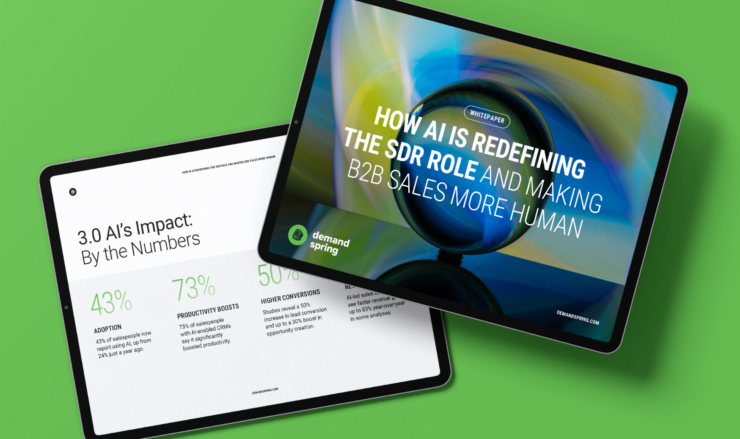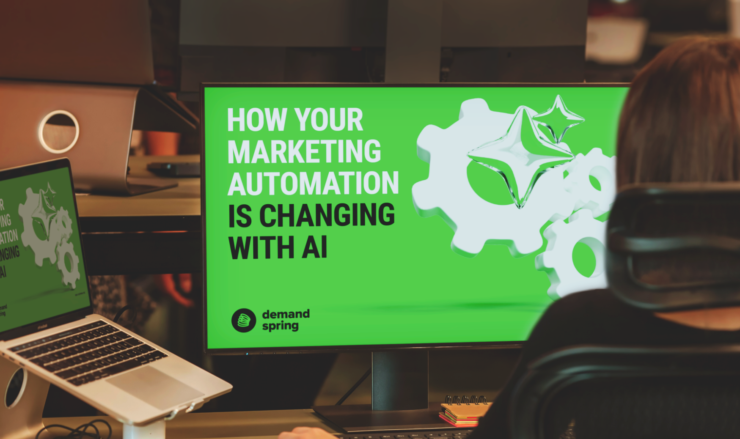Hear me out for a moment here – because I’m sharing a perspective that’s not going to be immediately intuitive – the net-new generative AI capabilities that burst onto the scene every day are reminiscent of the early days of marketing automation.
You’re doubtful there’s a connection; I don’t blame you. Was marketing automation the same level of technology leap? No. Not in the least. Generative AI (supported by a number of components of AI enabled tech) is, arguably, an Internet-level event. None among us ever looked at the children in our lives and wondered “I wonder how automated emails will impact little Mikey’s future.” But by now, you’ve asked that question about AI a few times a day. I’ve done the same.
So why the nostalgia? For better or worse, I’ve anchored my (professional) point of view in the last meaningful technology disruption that I experienced – marketing automation. Perhaps for you the last disruptive technology moment was the dawn of ABM. But I’d argue we were all a bit more sophisticated in our approach to digital marketing in 2016 than the decade before. I’m stuck in 2006 because my instinct is to purposely explore – what will we do, fellow B2B revenue marketers, with this step increase in speed, scale, and precision – for which we’re not necessarily prepared?
Consider 2006. What did we do as marketers when “digital” came? If you weren’t there, well, we weren’t perfect. We adored the technology . We relished the ability to send thousands of emails at a time. We watched volume numbers grow and that felt like success. Not uncommonly, we believed that learning the technology was learning marketing. As if marketing wasn’t experience design, persuasion, and helping audiences make more confident decisions.
Now, lots has changed. With access to the same level of technology advancement, our buyers evolved a whole lot as well (post for another day). And we matured. Over time we’ve learned that a little segmentation goes a long way (and more segmentation goes even further). We’ve learned that well-managed insights transform into relevant and welcome audience experiences. We’ve learned it’s about conversions more than it’s about sends. That’s not the sum of our accumulated knowledge over 20 years – that wouldn’t be fair. Importantly, we’ve learned that it’s not about the technology, it’s about applying technology to move our goals forward.
I ask you not to forget that in this time of dizzying innovation in generative AI specifically.
In plain words (there’s a pun coming), generative AI enables us to ask machines and algorithms to assemble new content – text, images, audio, slides, and more – in natural language (get it?). It’s the natural language part I want you to pay attention to here. Natural language prompts work as if you were talking to a peer. This replacement of coding languages and queries with natural language to create content is the focus of most (potentially all) of the new tools that are coming to your attention right now. Whichof course is huge. Using natural language to assemble structure around unstructured knowledge and data is revolutionary. Like I said at the beginning, an Internet-level event.
The opportunity? Endless. The challenge? A few. Among them, at least, is that for many of us generative AI has come along without a clear use case. So it’s left you and your peers seeking a clear one with questions like: Where do I use this right now? What are other CMOs doing? What’s my AI strategy supposed to be? What’s the playbook? Some applications are obvious. Accelerate content development? Absolutely. That’s a low hanging fruit you should pick. But is that the point? Of course not. It’s 2023, not 2006. We don’t pat ourselves on the back for content volume, we pat ourselves on the back for relevant content that inspires engagement and conversions.
Which leads me to AI Enablement.
AI Enablement is a term that’s meant to remind you that your course, your goals, your vision hasn’t changed. Let’s illustrate that with a different enabling technology like CDP. Perhaps you wanted deeper insights into your prospects so you could design superior experiences (your vision) and CDP enabled that. To take the analogy further; you don’t have a vision for a hammer, you have a vision for a new deck. Generative AI is a technique; it’s not a goal. It’s not the tool(s) that you’re going to learn to learn marketing. You’re not successful if you create more content just because you can. You’ve got to position the enabling technology to your goals. Don’t look for a use case for generative AI, its use is to enable.
So the question becomes, enable what? The answer is what it’s always been – even back in 2006. We’re still humans trying to figure out how to persuade other humans to engage with us, consider us when they need a solution to a business problem, and choose us despite alternatives and competition. Yes, I’m oversimplifying B2B revenue marketing. But let’s talk about a few of your likely intentions in your go-to-market strategy:
- Build brand preference and trust with an ICP audience
- Identify intent signals early and build experiences that appropriately leverage that intent
- Respect the journey of the independent, self-navigating, self-educating B2B buyer with information they need when they need it without being intrusive
- Create incredible product and non-product experiences for customers that enable friction-less renewals, logical upsells, and advocacy
When I consider that list, I see how much we need tools that enable our appeal to the decision makers that are behind every stage of the B2B buying process — from engagement to renewal. Every single micro-decision that levels up to those outcomes. Whether to register for your event. Whether to open an email. Whether to see your brand name on caller ID and pick up. Whether to have a conversation with you about renewal.
With generative AI, there’s an opportunity to impact every single interaction and make it more compelling, more personalized, and more persuasive to the individual decision maker. The opportunity we’ll be exploring at Demand Spring is using generative AI to improve your prospect and customer experience and move you closer to your specific goals.
It can be considered massively unintuitive that AI can help us sell to humans better. But that’s the essence of AI Enablement.
We’ll be using this language as we advise B2B revenue marketers on leveraging generative AI. We hope it serves as a reminder to not conflate the goal (solving a business problem) with a technique (the set of tools, processes, technology, and systems that we apply to that business problem).
In Part 2, we will delve deeper into crafting a practical AI Enablement plan based on 8 recommendations for effectively utilizing AI technology in your revenue marketing efforts and maintaining a strategic advantage.




